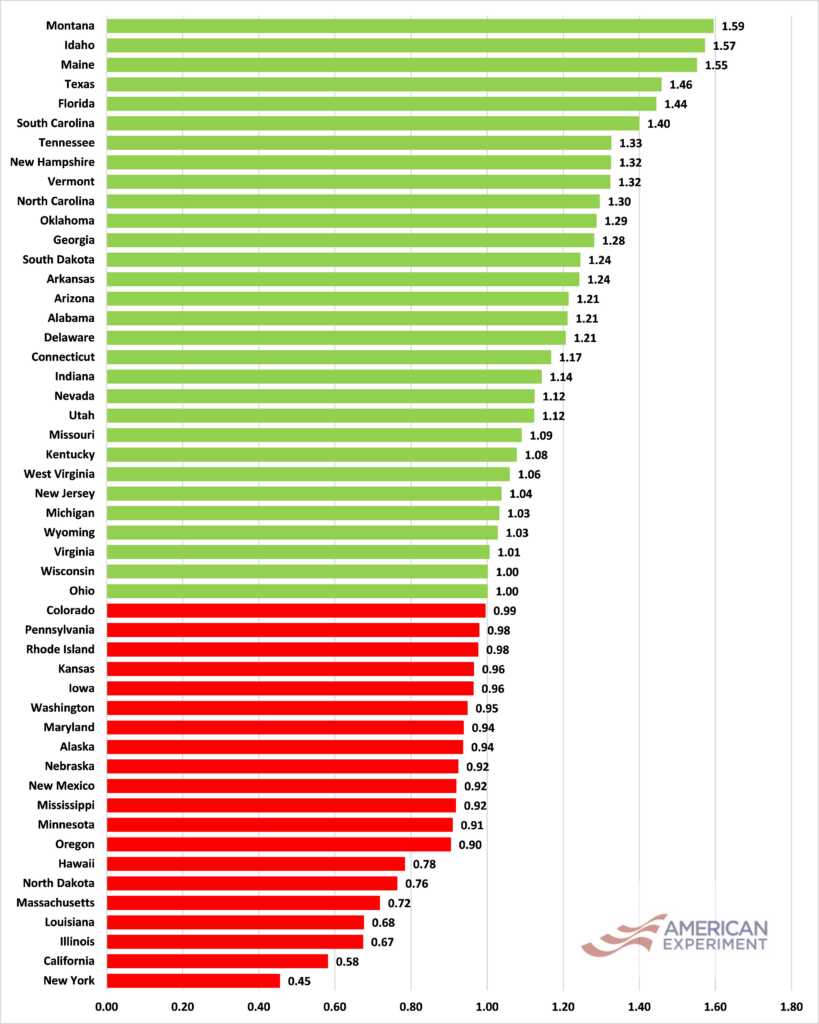Star Tribune article shows again how American Experiment leads the conversation on Minnesota’s economy
Last week, the Star Tribune carried an article by Evan Ramstad which provided a decent tour d’horizon of the economic debate in Minnesota. It showed, once again, how American Experiment leads the conversation on Minnesota’s economy.
Net migration: It isn’t just retirees
Citing Census Bureau data, Ramstad writes that retirees are “moving to Minnesota like crazy:”
From 2020 to 2022, the latest year for which age-related census data is available, twice as many people over age 65 moved to Minnesota as people ages 18 to 65 moved out of Minnesota.
…
After the 2020 census, 59,732 people older than 65 moved to Minnesota and 27,406 people in the working-age range of 18 to 65 moved away by summer 2022. That’s a net gain of 32,326 adults.
This echoes something I wrote in January last year (though I should add that I have not been able to replicate these numbers). Using Internal Revenue Service data, I noted that “Data show that Minnesota’s fleeing residents aren’t just retirees,” writing:
…contrary to the retirees and “Boomers” argument, our state sees this net loss of residents to other states across five of the six categories the IRS data breaks it down into, including those under 26.
In September last year, I asked “If Minnesota is the best state for Millennials, why do we have the 9th highest rate of Millennial out-migration?” I wrote:
Millennials — according to Pew Research Center — are those born between 1981 and 1996, making them aged between 27 and 42 (feeling old yet?). This overlaps, not perfectly but pretty well, with two categories which the Internal Revenue Service breaks its migration numbers down into — “26 under 35” and “35 under 45.” If we sum the number of individuals moving out of a state in these two categories and the number of individuals moving in, we can calculate a ratio of in-migrants to out-migrants by dividing the one by the other. A number greater than 1 means a net gain of Millennials and number less than 1 means a net loss. The results for 2020-2021, the most recent year for which we have data, are shown in Figure 1.
Figure 1: Ratio of Millennial in-migrants to out-migrants, 2020-2021

So, for example, South Dakota gained 15,221 Millennials and lost 12,138 giving a ratio (15,221/12,138) of 1.24. Minnesota, by contrast, lost 53,077 Millennials and gained 48,219 for a ratio of 0.91: in 2020-2021, Minnesota’s ratio of Millennial in-migrants to out-migrants was the ninth lowest in the United States.
Out migration exacerbates our labor shortage
Ramstad writes that:
…we should stop worrying about rich people moving to Florida and concentrate on Minnesota’s real problem: The net loss of people younger than 65 is troubling.
As [Mark] Haveman [who leads the Minnesota Center for Fiscal Excellence] put it, “That’s the workforce problem right there.”
This echoes something I wrote in June last year titled, “Migration won’t solve Minnesota’s labor shortage while policy drives people away.” “If we are to ease our state’s labor shortage by attracting workers from elsewhere,” I wrote, “we will need to reverse this exodus of Minnesotans. To do that, we must start by identifying the reasons they are leaving.”
Eliminating the lowest state income tax bracket is one way to cut taxes
Ramstad downplays the role of taxes in driving these problematic migration patterns, even though the empirical evidence finds that they are one factor behind them.
He goes on to note that:
The Minnesota Private Business Council recently proposed eliminating the state’s lowest income tax rate of 5.35%. It applies to individuals earning less than $40,000 and married couples under $50,000. The idea is distinctive coming from a right-leaning organization. Such groups typically promote tax cuts for higher-income people.
He should not be so surprised by this: We proposed exactly this policy in January 2023 in our Policy Briefing “Cut Minnesota’s Income Taxes:”
Our proposals are, then:
…
A cut in Minnesota’s bottom rate of state income tax to 1.25 percent in the 2024-25 biennium followed by its total elimination in the 2026-2027 biennium and further cut of the current 6.80 percent tax rate to 6.70 percent. There is no proposed change in the brackets.
“Tomorrow’s news today”
There is nothing wrong with tooting your own horn now and then. As the Star Tribune article shows, Center of the American Experiment has a track record of raising issues which few in our state want to discuss — but cannot, indefinitely, avoid — before anyone else. If you want to know what Minnesotans will be discussing tomorrow, look at what we are discussing today.